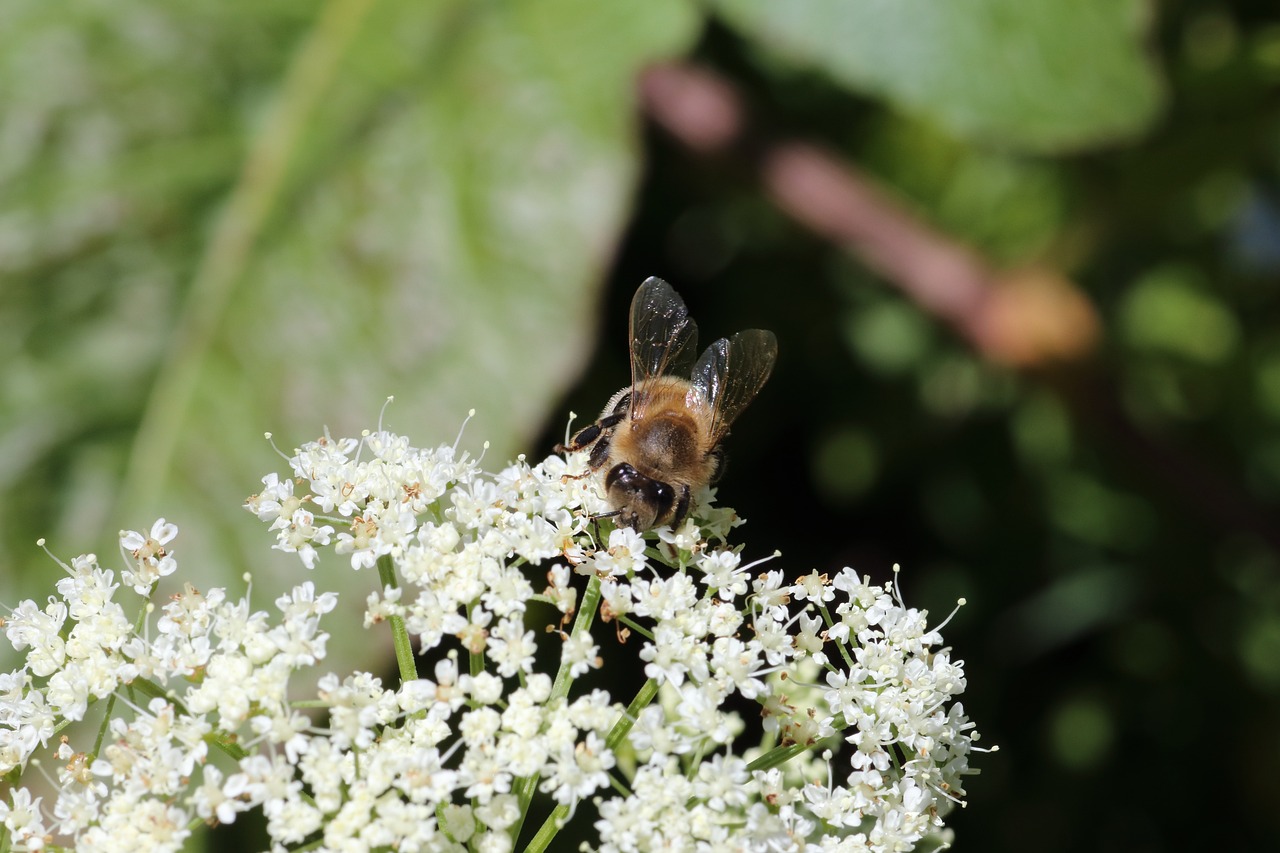To effectively control goutweed, a combination of physical removal, mulching, and herbicide application is recommended. Persistent efforts and monitoring are essential, as goutweed can quickly regrow from remaining roots or seeds. Timing and technique play crucial roles in successful eradication.
Understanding Goutweed

Goutweed, also known as Aegopodium podagraria, is a perennial herb that can be highly invasive in gardens and natural landscapes. Originally introduced as a ground cover, it has become notorious for its rapid growth and ability to spread aggressively. This plant thrives in a variety of soil conditions and can tolerate shade, making it a formidable opponent for gardeners trying to maintain their landscapes.
One of the challenges with goutweed is its extensive root system. The roots can penetrate deep into the soil, creating a network that allows the plant to regenerate even after partial removal. Additionally, goutweed can produce seeds that contribute to its spread, making it essential to address both roots and seeds when attempting to control this invasive species.
Why Control Goutweed?
Controlling goutweed is crucial for several reasons. First, it competes aggressively with native plants and desirable garden species for nutrients, light, and space. This competition can lead to reduced biodiversity in local ecosystems. Second, its rapid growth can create a dense mat that is difficult to navigate, making gardens less enjoyable and accessible.
Moreover, goutweed can alter soil structure and affect moisture levels in the surrounding area. As it spreads, it may create conditions that favor further invasions of other non-native species. Therefore, managing goutweed not only helps preserve a garden’s aesthetic appeal but also supports overall ecological health.
Methods for Controlling Goutweed
To effectively control goutweed, several methods can be employed either individually or in combination. Understanding these methods is key to developing a robust approach to eradication.
Physical Removal
Physical removal is one of the most straightforward methods to tackle goutweed. This involves digging out the plant along with its roots. However, it is important to follow certain guidelines:
- Remove all visible parts of the plant including leaves and stems.
- Use a spade or garden fork to carefully dig out the roots.
- Dispose of removed plant material properly to prevent re-establishment.
Repeated efforts are often necessary, as any remaining root fragments can lead to regrowth. Monitoring the area regularly after removal is essential to catch any new sprouts early.
Mulching
Another effective method is mulching. Applying a thick layer of mulch can suppress goutweed’s growth by blocking light and limiting its ability to photosynthesize. Organic mulches such as wood chips or straw work well. Key points about mulching include:
- Apply at least 3-4 inches of mulch depth for effective suppression.
- Ensure that the mulch is kept moist to promote decomposition.
- Replenish mulch as needed to maintain coverage.
Herbicides
If physical removal and mulching do not yield satisfactory results, herbicides may be considered. It is crucial to choose a product specifically designed for controlling perennial weeds. When using herbicides:
- Follow the manufacturer’s instructions carefully.
- Apply during the growing season when the plant is actively photosynthesizing.
- Avoid contact with desirable plants to minimize damage.
Combining these methods can increase effectiveness and help manage goutweed more sustainably over time.
Integrated Approaches for Goutweed Control
Beyond individual methods, an integrated approach to goutweed control can yield the best results. This strategy combines physical removal, mulching, and herbicide application while also incorporating environmental management practices. By understanding the strengths and weaknesses of each method, gardeners can develop a more comprehensive plan for managing goutweed effectively.
Timing and Persistence
One key factor in controlling goutweed is the timing of interventions. Implementing control measures at the right time can significantly enhance their effectiveness. Consider the following points:
- Early Spring: This is an optimal time for physical removal as the plants are just starting to grow. Removing them early can prevent them from establishing a stronger root system.
- Late Summer to Early Fall: Herbicide application during this period allows the chemicals to be absorbed more efficiently, targeting the plant when it is actively storing energy in its roots.
- Continuous Monitoring: Regularly check areas previously infested with goutweed. Being vigilant allows for prompt action against new growth.
Companion Planting
Another effective tactic involves companion planting. By introducing certain plants that compete with goutweed for resources, you can help suppress its growth. Some beneficial companion plants include:
- Native Grasses: These plants can create a dense growth habit that shades out goutweed.
- Perennial Flowers: Establishing a diverse planting scheme can help create a more balanced ecosystem, limiting goutweed’s ability to thrive.
- Ground Covers: Low-growing ground covers can outcompete goutweed for nutrients and space.
When selecting companion plants, it is essential to choose species that are well-adapted to your local environment and can thrive alongside desired garden plants.
Soil Management
Soil health plays a crucial role in the success of any gardening endeavor, including goutweed control. Improving soil conditions can create an environment less conducive to the growth of invasive weeds. Important practices include:
- Enhancing Soil Fertility: Use organic matter like compost to enrich the soil, promoting healthy plant growth while discouraging invasive species.
- Aerating Soil: Compacted soil can benefit from aeration, which improves water infiltration and root growth for desired plants, giving them an advantage over goutweed.
- pH Balance: Testing and adjusting soil pH can create unfavorable conditions for goutweed while supporting the growth of native plants.
Monitoring and Maintenance
A successful goutweed control plan requires ongoing monitoring and maintenance. After implementing initial control methods, it is essential to remain vigilant. Here are some key strategies to ensure long-term success:
Regular Inspections
Conducting regular inspections of garden areas is vital. Look for signs of new growth or resprouting. Early detection allows for quick intervention before goutweed can re-establish itself.
Record Keeping
Maintaining a detailed record of your efforts can be invaluable. Document the following:
- Date and method of removal or treatment applied.
- Observations regarding plant health and any regrowth.
- Weather conditions that may affect plant growth or herbicide effectiveness.
This information can help refine strategies over time, ensuring that future interventions are more targeted and effective.
Community Involvement
Engaging with neighbors and community members can strengthen efforts against goutweed. By sharing knowledge and resources, community members can coordinate efforts to control invasive weeds collectively. Consider the following collaborative strategies:

- Neighborhood Clean-Up Days: Organize events focused on removing invasive species from shared spaces.
- Educational Workshops: Hold workshops to educate others about recognizing goutweed and effective management techniques.
- Shared Resources: Pool resources such as tools or herbicides to make eradication efforts more efficient.
This collaborative approach not only enhances individual efforts but also fosters a sense of community commitment to maintaining healthy landscapes.
Challenges in Controlling Goutweed

While there are effective methods for controlling goutweed, several challenges can complicate the eradication process. Understanding these challenges is essential for developing a successful management strategy. Below are some common issues faced by gardeners and land managers.
Regrowth from Fragments
One of the most significant challenges in controlling goutweed is its ability to regrow from even small root fragments left in the soil. The following points highlight this issue:
- Root Fragment Viability: Even a tiny piece of root can regenerate into a new plant, making thorough removal critical.
- Soil Disturbance: Activities such as digging or tilling can inadvertently break roots into smaller pieces, exacerbating the problem.
- Persistence: Goutweed can remain dormant in the soil for years, only to resurge when conditions become favorable.
To mitigate this issue, it is essential to take extra care during the removal process, ensuring that all visible roots are excavated and disposed of properly.
Environmental Factors
Environmental conditions also play a crucial role in goutweed management. Factors such as weather, soil type, and moisture levels can influence the effectiveness of control methods. Consider the following:
- Moisture Levels: Goutweed thrives in moist environments. Excessive rainfall can lead to rapid growth, while dry conditions may stress desirable plants, giving goutweed an advantage.
- Soil Conditions: Poorly drained or compacted soils can favor the growth of goutweed by reducing competition from other plants.
- Seasonal Variability: Weather patterns can affect the timing of herbicide application and physical removal efforts. Keeping an eye on local climate conditions is essential for successful intervention.
Herbicide Selection and Application
If herbicides are part of your management strategy, choosing the right product and applying it effectively is critical. Different herbicides target specific types of weeds, so understanding their active ingredients and application methods is vital.
Types of Herbicides
Common herbicides used for controlling goutweed include:
- Glyphosate: A non-selective herbicide that kills most plants it comes into contact with. It is effective but requires careful application to avoid harming desirable plants.
- Triclopyr: This selective herbicide targets broadleaf plants while sparing grasses. It can be particularly effective for goutweed when applied correctly.
- Imazapyr: Another selective option that is effective against perennial weeds but should be used with caution due to its residual effects in the soil.
Application Techniques
The method of application can significantly affect the success of herbicide treatments. Consider these techniques:
- Spot Treatment: Applying herbicide directly to the leaves of goutweed minimizes exposure to surrounding plants and enhances effectiveness.
- Foliar Application: This involves spraying the herbicide on the foliage when plants are actively growing. Timing is crucial for maximum absorption.
- Soil Application: Some herbicides can be applied to the soil to target roots directly. This method may require special equipment for even distribution.
Always follow the manufacturer’s guidelines for dosage and safety precautions when using herbicides to minimize risks to human health and the environment.
Long-Term Management Strategies
Sustained efforts are necessary to ensure long-term control of goutweed. Incorporating a variety of management strategies can help prevent re-infestation and maintain a healthy garden ecosystem.
Cultural Practices
Cultural practices can create an environment that discourages goutweed growth while promoting desirable plants. Here are some practices to consider:
- Diverse Planting: Cultivating a variety of native plants can lead to a more balanced ecosystem, reducing the likelihood of invasive species establishing dominance.
- Regular Maintenance: Continuous care, including weeding and monitoring, helps keep invasive species at bay and promotes healthy plant growth.
- Avoiding Soil Disturbance: Reduced tillage and careful planting techniques help maintain soil integrity, preventing root fragments from breaking off and spreading.
Employing these long-term strategies alongside immediate control measures ensures that gardeners not only address existing infestations but also create conditions that deter future growth of goutweed.
Alternative and Organic Control Methods

For those looking to manage goutweed without the use of chemical herbicides, alternative and organic control methods can be effective. These approaches often focus on enhancing ecological balance while minimizing environmental impact. Here are several options to consider:
Natural Herbicides
Natural herbicides derived from plant-based ingredients can be a safer alternative. Some options include:
- Vinegar: Household vinegar contains acetic acid, which can be effective against goutweed when applied directly to the leaves. It is most effective on sunny days when the plant is actively growing.
- Citrus Oil: Extracts from citrus fruits can serve as natural herbicides. They work by breaking down the plant’s cellular structure, leading to desiccation.
- Salt Solutions: Salt can dehydrate plants, but caution is advised as it can also harm surrounding soil and plants if not used judiciously.
Boiling Water
Poured directly onto goutweed, boiling water can effectively kill the plant. This method is particularly useful for small patches but requires careful application to avoid damaging nearby plants.
Cover Crops
Planting cover crops such as clover or rye can help suppress goutweed’s growth. These crops compete for resources, thus limiting the space and nutrients available for goutweed. Additionally, they can improve soil health when tilled back into the soil.
Community Education and Awareness
Education plays a vital role in controlling invasive species like goutweed. By fostering awareness within communities about the impacts of this invasive plant, individuals can take proactive measures to prevent its spread. Here are some strategies for enhancing community education:
- Informational Campaigns: Distribute flyers or utilize social media platforms to inform the public about identifying and managing goutweed.
- Workshops and Demonstrations: Organize events where community members can learn about effective management techniques firsthand.
- Invasive Species Alerts: Establish a local network to report sightings of goutweed and other invasive species, encouraging timely action.
Final Thoughts
Controlling goutweed requires a multifaceted approach that combines various techniques and strategies. As an invasive species, goutweed poses challenges that necessitate persistence and vigilance. By employing methods such as physical removal, mulching, herbicide application, and alternative controls, gardeners can effectively manage this invasive plant.
Moreover, integrating cultural practices and fostering community involvement creates a comprehensive strategy that enhances long-term control efforts. Education and collaboration are essential components, helping to raise awareness about the ecological impacts of goutweed and encouraging proactive measures within communities.
Ultimately, by understanding the nature of goutweed and implementing effective management techniques, individuals can reclaim their spaces from this invasive weed. The journey may be challenging, but with dedication and informed strategies, it is possible to restore balance to gardens and natural areas alike.
